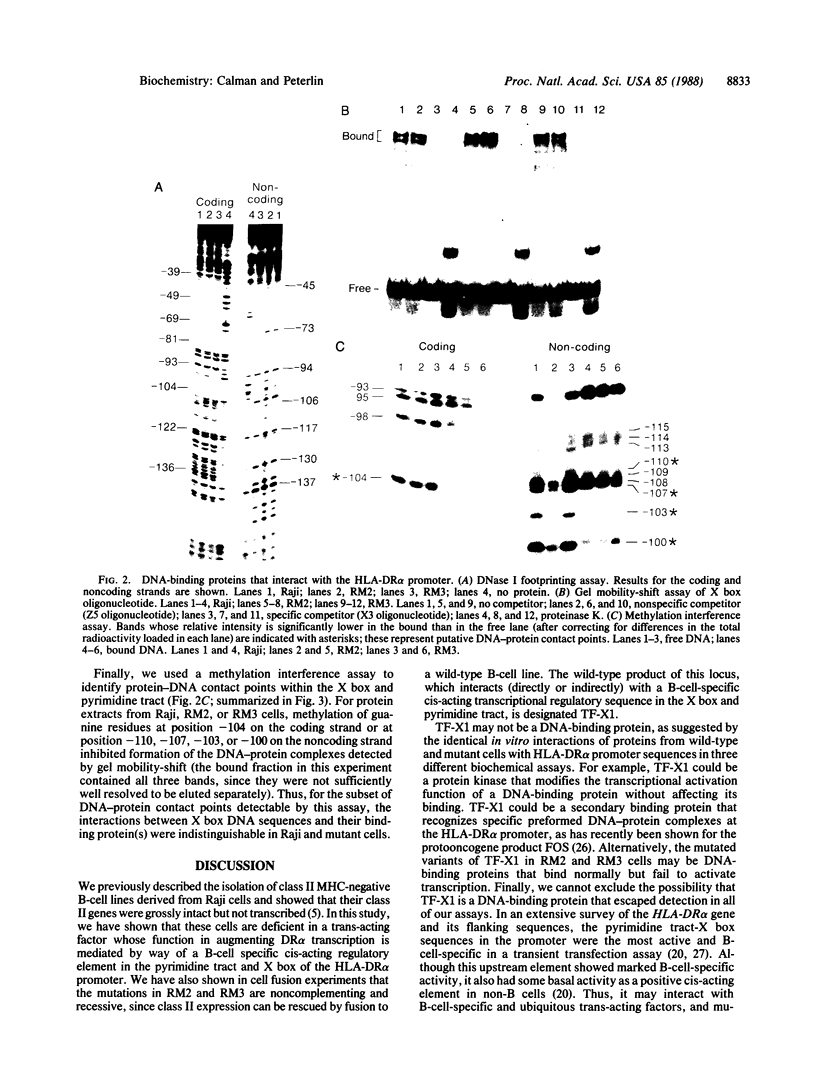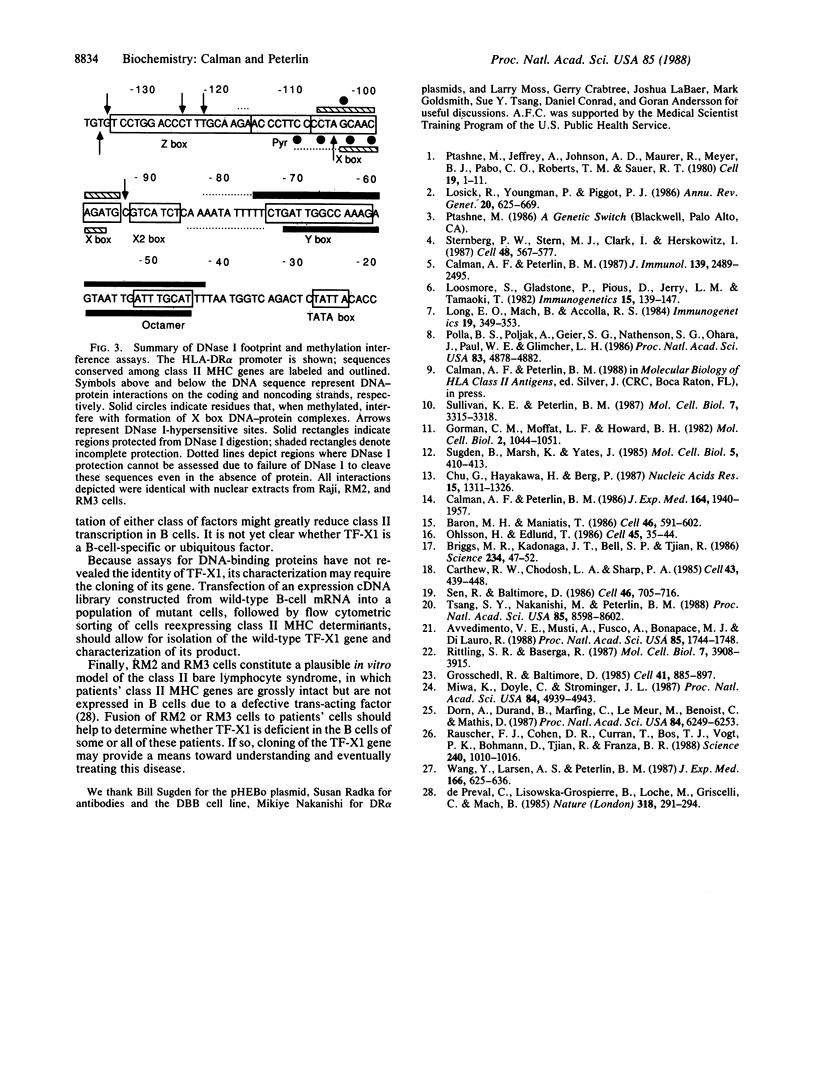Abstract
The study of specific trans-acting transcription factors in prokaryotes and lower eukaryotes has been greatly facilitated by genetic analysis of mutant strains deficient in such factors. We have developed such a system to study mammalian trans-acting factors that regulate the transcription of class II major histocompatibility complex genes, using the mutant cell lines RM2 and RM3. These cells, derived from the human B-cell line Raji, specifically fail to transcribe their class II major histocompatibility complex genes. Here we show that a transfected HLA-DR alpha class II major histocompatibility complex gene, like the endogenous HLA-DR alpha genes, is efficiently transcribed in Raji cells but not in RM2 or RM3 cells, demonstrating that the mutant cells are deficient in a specific trans-acting factor required for transcription of these genes. HLA-DR expression in RM2 and RM3 cells is rescued by fusion to another B-cell line but not by fusion to each other. Thus, the defects in the two cell lines are recessive and noncomplementing and define a locus whose wild-type product we designate TF-X1. We show that TF-X1 influences the activity of a 24-base-pair B-cell-specific cis-acting transcription element in the HLA-DR alpha promoter. However, in three different biochemical assays, we detect no difference between wild-type and mutant cells in the DNA-binding proteins that interact with these DNA sequences. Thus, the defective version of TF-X1 may be a DNA-binding protein that binds to the HLA-DR alpha promoter but fails to activate transcription. Alternatively, TF-X1 may not be a DNA-binding protein at all.
Full text
PDF




Images in this article
Selected References
These references are in PubMed. This may not be the complete list of references from this article.
- Avvedimento V. E., Musti A., Fusco A., Bonapace M. J., Di Lauro R. Neoplastic transformation inactivates specific trans-acting factor(s) required for the expression of the thyroglobulin gene. Proc Natl Acad Sci U S A. 1988 Mar;85(6):1744–1748. doi: 10.1073/pnas.85.6.1744. [DOI] [PMC free article] [PubMed] [Google Scholar]
- Baron M. H., Maniatis T. Rapid reprogramming of globin gene expression in transient heterokaryons. Cell. 1986 Aug 15;46(4):591–602. doi: 10.1016/0092-8674(86)90885-8. [DOI] [PubMed] [Google Scholar]
- Briggs M. R., Kadonaga J. T., Bell S. P., Tjian R. Purification and biochemical characterization of the promoter-specific transcription factor, Sp1. Science. 1986 Oct 3;234(4772):47–52. doi: 10.1126/science.3529394. [DOI] [PubMed] [Google Scholar]
- Calman A. F., Peterlin B. M. Expression of T cell receptor genes in human B cells. J Exp Med. 1986 Dec 1;164(6):1940–1957. doi: 10.1084/jem.164.6.1940. [DOI] [PMC free article] [PubMed] [Google Scholar]
- Calman A. F., Peterlin B. M. Mutant human B cell lines deficient in class II major histocompatibility complex transcription. J Immunol. 1987 Oct 1;139(7):2489–2495. [PubMed] [Google Scholar]
- Carthew R. W., Chodosh L. A., Sharp P. A. An RNA polymerase II transcription factor binds to an upstream element in the adenovirus major late promoter. Cell. 1985 Dec;43(2 Pt 1):439–448. doi: 10.1016/0092-8674(85)90174-6. [DOI] [PubMed] [Google Scholar]
- Chu G., Hayakawa H., Berg P. Electroporation for the efficient transfection of mammalian cells with DNA. Nucleic Acids Res. 1987 Feb 11;15(3):1311–1326. doi: 10.1093/nar/15.3.1311. [DOI] [PMC free article] [PubMed] [Google Scholar]
- Dorn A., Durand B., Marfing C., Le Meur M., Benoist C., Mathis D. Conserved major histocompatibility complex class II boxes--X and Y--are transcriptional control elements and specifically bind nuclear proteins. Proc Natl Acad Sci U S A. 1987 Sep;84(17):6249–6253. doi: 10.1073/pnas.84.17.6249. [DOI] [PMC free article] [PubMed] [Google Scholar]
- Gorman C. M., Moffat L. F., Howard B. H. Recombinant genomes which express chloramphenicol acetyltransferase in mammalian cells. Mol Cell Biol. 1982 Sep;2(9):1044–1051. doi: 10.1128/mcb.2.9.1044. [DOI] [PMC free article] [PubMed] [Google Scholar]
- Grosschedl R., Baltimore D. Cell-type specificity of immunoglobulin gene expression is regulated by at least three DNA sequence elements. Cell. 1985 Jul;41(3):885–897. doi: 10.1016/s0092-8674(85)80069-6. [DOI] [PubMed] [Google Scholar]
- Long E. O., Mach B., Accolla R. S. Ia-negative B-cell variants reveal a coordinate regulation in the transcription of the HLA class II gene family. Immunogenetics. 1984;19(4):349–353. doi: 10.1007/BF00345408. [DOI] [PubMed] [Google Scholar]
- Loosmore S., Gladstone P., Pious D., Jerry L. M., Tamaoki T. Control of HLA-DR antigen gene expression at the pretranslational level: comparison of an HLA-DR-positive B lymphoblastoid cell line and its HLA-DR-negative variant. Immunogenetics. 1982;15(2):139–150. doi: 10.1007/BF00621947. [DOI] [PubMed] [Google Scholar]
- Losick R., Youngman P., Piggot P. J. Genetics of endospore formation in Bacillus subtilis. Annu Rev Genet. 1986;20:625–669. doi: 10.1146/annurev.ge.20.120186.003205. [DOI] [PubMed] [Google Scholar]
- Miwa K., Doyle C., Strominger J. L. Sequence-specific interactions of nuclear factors with conserved sequences of human class II major histocompatibility complex genes. Proc Natl Acad Sci U S A. 1987 Jul;84(14):4939–4943. doi: 10.1073/pnas.84.14.4939. [DOI] [PMC free article] [PubMed] [Google Scholar]
- Ohlsson H., Edlund T. Sequence-specific interactions of nuclear factors with the insulin gene enhancer. Cell. 1986 Apr 11;45(1):35–44. doi: 10.1016/0092-8674(86)90535-0. [DOI] [PubMed] [Google Scholar]
- Polla B. S., Poljak A., Geier S. G., Nathenson S. G., Ohara J., Paul W. E., Glimcher L. H. Three distinct signals can induce class II gene expression in a murine pre-B-cell line. Proc Natl Acad Sci U S A. 1986 Jul;83(13):4878–4882. doi: 10.1073/pnas.83.13.4878. [DOI] [PMC free article] [PubMed] [Google Scholar]
- Ptashne M., Jeffrey A., Johnson A. D., Maurer R., Meyer B. J., Pabo C. O., Roberts T. M., Sauer R. T. How the lambda repressor and cro work. Cell. 1980 Jan;19(1):1–11. doi: 10.1016/0092-8674(80)90383-9. [DOI] [PubMed] [Google Scholar]
- Rauscher F. J., 3rd, Cohen D. R., Curran T., Bos T. J., Vogt P. K., Bohmann D., Tjian R., Franza B. R., Jr Fos-associated protein p39 is the product of the jun proto-oncogene. Science. 1988 May 20;240(4855):1010–1016. doi: 10.1126/science.3130660. [DOI] [PubMed] [Google Scholar]
- Rittling S. R., Baserga R. Functional analysis and growth factor regulation of the human vimentin promoter. Mol Cell Biol. 1987 Nov;7(11):3908–3915. doi: 10.1128/mcb.7.11.3908. [DOI] [PMC free article] [PubMed] [Google Scholar]
- Sen R., Baltimore D. Multiple nuclear factors interact with the immunoglobulin enhancer sequences. Cell. 1986 Aug 29;46(5):705–716. doi: 10.1016/0092-8674(86)90346-6. [DOI] [PubMed] [Google Scholar]
- Sternberg P. W., Stern M. J., Clark I., Herskowitz I. Activation of the yeast HO gene by release from multiple negative controls. Cell. 1987 Feb 27;48(4):567–577. doi: 10.1016/0092-8674(87)90235-2. [DOI] [PubMed] [Google Scholar]
- Sugden B., Marsh K., Yates J. A vector that replicates as a plasmid and can be efficiently selected in B-lymphoblasts transformed by Epstein-Barr virus. Mol Cell Biol. 1985 Feb;5(2):410–413. doi: 10.1128/mcb.5.2.410. [DOI] [PMC free article] [PubMed] [Google Scholar]
- Sullivan K. E., Peterlin B. M. Transcriptional enhancers in the HLA-DQ subregion. Mol Cell Biol. 1987 Sep;7(9):3315–3319. doi: 10.1128/mcb.7.9.3315. [DOI] [PMC free article] [PubMed] [Google Scholar]
- Tsang S. Y., Nakanishi M., Peterlin B. M. B-cell-specific and interferon-gamma-inducible regulation of the HLA-DR alpha gene. Proc Natl Acad Sci U S A. 1988 Nov;85(22):8598–8602. doi: 10.1073/pnas.85.22.8598. [DOI] [PMC free article] [PubMed] [Google Scholar]
- Wang Y., Larsen A. S., Peterlin B. M. A tissue-specific transcriptional enhancer is found in the body of the HLA-DR alpha gene. J Exp Med. 1987 Sep 1;166(3):625–636. doi: 10.1084/jem.166.3.625. [DOI] [PMC free article] [PubMed] [Google Scholar]
- de Préval C., Lisowska-Grospierre B., Loche M., Griscelli C., Mach B. A trans-acting class II regulatory gene unlinked to the MHC controls expression of HLA class II genes. Nature. 1985 Nov 21;318(6043):291–293. doi: 10.1038/318291a0. [DOI] [PubMed] [Google Scholar]









